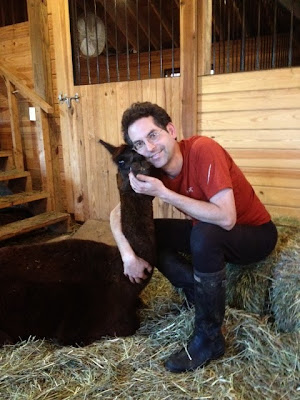The orchard and cider house have been put to bed. I racked the last 60 liters of our fermented cider into three 20 liter Spiedel tanks and inoculated two of them with malolactic bacteria (Oenococcus oenii) to soften the acids and round out the flavor. We'll bottle still and sparking cider in the Spring.
The hoop house is filled with salad greens, thriving in the balmy temperatures of cold frames and planting blankets. The soil temperature of our 15 raised beds is between 50-60 in winter.
The ducks are now 12 weeks old and have begun to venture beyond their duck pen and spend the day with the chickens and guineas.
The guinea fowl have decided that the duck pond is a spa and enjoy washing their feet in the running water.
The mushroom logs are dormant in the cold but the oyster and shitake cultures within them continue to thrive. We've removed the roof of the shade house so that it does not collapse under the weight of snow and ice.
The farmhouse is the focal point for entire family - my wife, my daughter, my mother, my daughter's boyfriend, his parents, and my father in law are all gathered for a vegan feast.
A cheery fire is burning in the heath - a mixture of ash and maple woods from the 10 cords I've cut and split this season.
2013 has been a year of high highs and low lows. This is the first Christmas without my father. My wife's cancer is gone, my daughter's semester at Tufts was very successful, and all the creatures at Unity Farm are thriving.
In a world with decreasing resources, an increasing population, and accelerating change, there's a tendency to lose civility. My own experiences this year have reinforced the importance of maintaining equanimity in the face of adversity. As the year draws to a close, there is no regret for anything I've done or not done, professionally or personally. The holiday season in 2013 will be an excellent wrapper around one of the most tumultuous years of my wife.
As 2014 approaches, I can only hope that our happiness persists, regulatory burdens diminish, and breakthrough innovations become our standard work.
Happy Holidays to all!















